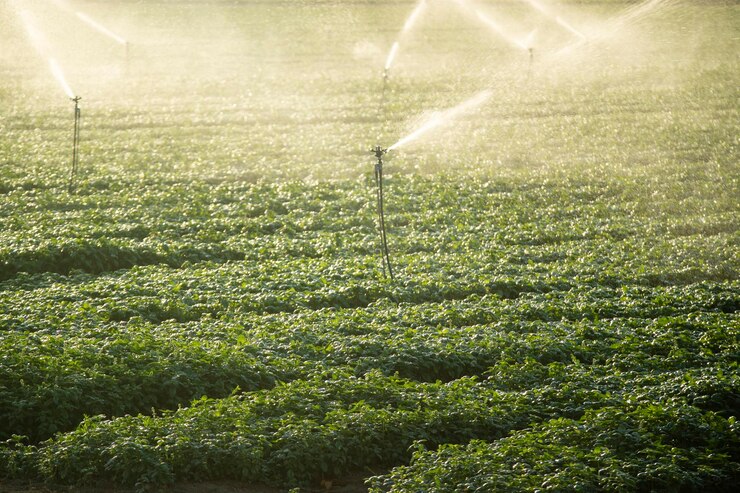The use of technology in landscaping and contemporary agriculture has completely changed conventional methods. Automated irrigation systems are one such invention that has become well known. These systems, which are driven by sophisticated sensors and controls, have many benefits and are thus essential resources for landscapers, farmers, and gardeners.
Efficient Water Management
The ability of automated irrigation systems for efficient water management is at the forefront of their benefits. These systems make sure that water is given exactly where and when it is required by using sensors to assess soil moisture levels, weather, and plant requirements.
Automated watering systems maximise water use by doing away with the guesswork associated with manual techniques. In areas where drought is a problem, this is especially important since it lessens waste and encourages conservation.
Precision and Customisation
The accuracy and customizability of automated watering systems is another significant benefit. Users may adjust watering schedules with programmable controllers to suit certain plant species, kinds of soil, and environmental conditions.
With these systems, you may change the frequency, length, or timing of watering cycles, giving you unmatched versatility to meet the demands of a variety of landscapes and irrigation setups. This kind of accuracy not only improves plant development and health but also reduces the possibility of overwatering or underwatering, which lessens the chance of plant stress and disease.
Increased Property Value
Residential and commercial buildings’ visual appeal and value can be markedly improved by automated watering systems. Properly managed irrigation systems foster a serene and well-maintained atmosphere that improves curb appeal and makes a lasting impression on both guests and prospective purchasers.
Rich lawns, colourful flower beds, and flourishing vegetation add value to a property and draw in purchasers who are looking for a well-balanced combination of appearance and function.
A well-maintained irrigation system can consist of retractable hose reels that deliver a convenient way to store and also the transport garden hoses, diminishing clutter and tangling. This, however, makes the property appear more organized and inviting, additionally adding to its overall magnificence.
Labour and Time Savings
Automated irrigation systems are a labour and time-saving marvel in a time when efficiency is crucial. Users are freed from the tedious work of manual irrigation by automating the watering process, which enables them to focus their time and resources on other crucial areas of farming or landscaping.
These systems are remotely accessible, so that users may monitor and modify irrigation settings from any location, negating the need for continual on-site monitoring. For both homeowners and agricultural practitioners, this degree of ease not only improves work-life balance but also simplifies operating efficiency.
Enhanced Plant Health and Growth
There is no denying the link between healthy plants and proper hydration, and controlled irrigation systems are essential for creating the best possible growth environment. Through accurate and consistent water delivery to the root, these systems encourage strong root growth and nutrient uptake, resulting in stronger, healthier plants.
Moreover, automatic irrigation reduces the stresses brought on by waterlogging or drought by decreasing variations in soil moisture levels, which improves overall plant health and yield. Rich green lawns, abundant crops, and colourful sceneries that please the sight and uplift the spirit are the end results.
Environmental Sustainability
Automated irrigation systems support more general environmental sustainability objectives in addition to the immediate advantages they provide for plant productivity and health. By lowering the danger of soil erosion and nutrient leaching and reducing water waste and runoff, these systems contribute to the preservation of valuable freshwater resources.
Using effective irrigation techniques can result in significant energy savings, especially in areas where a large amount of agricultural energy is used for water pumping. Farmers, gardeners, and landscapers show their dedication to environmental stewardship and preserving natural resources for future generations by implementing automated irrigation solutions.
Risk Mitigation
Automated irrigation systems are essential instruments for risk reduction in areas where weather patterns are erratic. They protect gardens, crops, and landscapes from the damaging impacts of heat waves, droughts, and other extreme weather conditions.
These systems offer an extra degree of resilience by continually monitoring the environment and modifying watering schedules appropriately, guaranteeing that plants receive enough moisture levels even in the face of meteorological uncertainty. Consequently, this helps farmers and landscapers protect their investments and means of subsistence by reducing yield losses, maintaining crop quality, and maintaining the attractiveness of their landscapes.
Data-Driven Insights
Users of automated irrigation systems may make well-informed judgements and improve irrigation practices over time with the help of these insightful data-driven insights. Users are able to fine-tune watering schedules, modify irrigation tactics, and pinpoint areas that require improvement by using the insightful input these systems give.
Smart analytics and predictive modelling may be combined to optimise water savings and open up new efficiencies for consumers. They are able to maximise crop production as a result, which promotes innovation and ongoing development in farming and landscaping techniques.
Disease Prevention
Automated irrigation systems help prevent illness by reducing the amount of environments that are favourable to bacterial and fungal pathogens. These systems help maintain dry foliage by directing water directly to the root zone and minimising overhead irrigation. By reducing the circumstances that might encourage the spread of diseases, this lowers the danger of plant infections.
In order to ensure healthier plants and greater agricultural yields, it is also possible to modify watering schedules in response to weather conditions.
Labour Allocation Efficiency
Automated irrigation systems maximise the use of labour by releasing important human capital for higher-value, more strategic duties. These technologies save up agricultural workers’ and landscapers’ time by automating the labor-intensive manual watering procedure. Instead, they may concentrate their skills on activities that call for creativity, critical thinking, and problem-solving.
The ability to assign irrigation chores to automated systems improves overall operational efficiency and productivity, allowing organisations to accomplish more with less resources, whether it’s crop monitoring, soil analysis, or landscape design. This lowers labour costs and boosts employee morale, which in turn creates a more engaged and active workforce in the landscaping and agriculture industries.
Regulatory Compliance
Automated irrigation systems provide a way for agricultural and landscaping firms operating in areas with water consumption limitations and restrictions to ensure compliance with municipal legislation and conservation standards. Users can reduce water usage while still fulfilling crop or landscape demands by employing precise water management strategies and improving irrigation efficiency.
This proactive strategy not only helps businesses avoid penalties and fines for water waste, but it also reflects a dedication to environmental care. It also encourages sustainable water management methods, which improves businesses’ reputations and trustworthiness in the community.
Conclusion
The introduction of automated irrigation systems ushers in a new era of efficiency, accuracy, and sustainability in agriculture and landscaping. The benefits are numerous and far-reaching, ranging from effective water management to improved plant health and environmental protection. As we face the problems of a fast changing climate and a growing global population, integrating innovative technology like automated irrigation systems becomes increasingly important.

